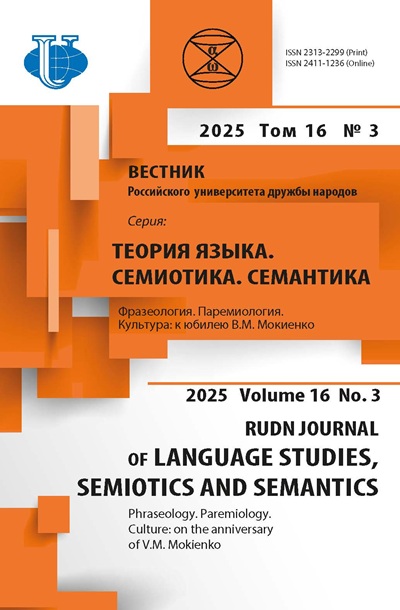Какого цвета чувства? (на материале английских идиом с цветообозначениями)
- Авторы: Пасечник Т.Б.1, Савельева И.Г.1
-
Учреждения:
- Государственный социально-гуманитарный университет
- Выпуск: Том 10, № 3 (2019): Парадигмы функциональной семантики XXI века
- Страницы: 714-721
- Раздел: КОНЦЕПТОСФЕРА И ЭСТЕТИЧЕСКАЯ ФУНКЦИЯ ДРАМАТУРГИЧЕСКОГО ТЕКСТА И ДИСКУРСА
- URL: https://journals.rudn.ru/semiotics-semantics/article/view/22128
- DOI: https://doi.org/10.22363/2313-2299-2019-10-3-714-721
- ID: 22128
Цитировать
Полный текст
Аннотация
В настоящей статье предметом исследования являются частично или полностью переосмысленные английские фразеологизмы со значением «эмоция», имеющие в своей структуре цветовой компонент. Объектом рассмотрения являются особенности эмотивного компонента идиом, входящих в эту группу. В работе предпринимается попытка показать, что цветообозначения, соотносимые с понятиями «теплый» и «холодный», определяют семантику всей устойчивой группы, образно передающей эмоции человека. Рассмотрение вопросов, связанных с употреблением цветовых компонентов в идиоме, неизбежно предполагает обращение к самому важному компоненту фразеологичности - идиоматичности, которая основывается на переинтерпретации выражения и непрозрачности его значения. В статье анализируются примеры не только фразеологизмов, исторически восходящих к свободным словосочетаниям, но и выражения, которые в буквальном значении в языке не употребляются. Изучаемая группа идиом с цветовым компонентом преимущественно представлена выражениями с непрозрачной семантической структурой. На примере цветообозначений демонстрируются процессы, когда переинтерпретация может относиться не только к целому выражению, но и к его компонентам. В этом случае цветовой компонент в идиоме приобретает новую семантику, более не обозначая цвет в буквальном смысле слова, и, таким образом, вносит в семантическую структуру идиом со значением «эмоции» новый смысл. Важно отметить, что в фокус исследования попадают немногочисленные базовые цветообозначения; огромное число слов со значением цветовых оттенков не передают в английском языке эмоциональных значений. Но в других языках, возможно, мы сможем найти их в структуре устойчивых выражений, что объясняется своеобразием мировосприятия разными народами. Язык как чуткий индикатор фиксирует все сходства и различия. Изучаемая проблема актуальна, так как обусловлена возрастающим в современной лингвистике интересом к исследованию механизмов вторичной номинации в разных языках и выявлению на материале фразеологизмов специфических особенностей вербального мышления и восприятия действительности языковыми коллективами. Лингвисты, в особенности типологии и этимологи, исследовали десятки языков и выявили ряд универсальных черт в системе цветообозначения. Однако наряду с универсалиями в ее развитии обнаруживаются и существенные национально-культурные особенности. Анализ подобного рода привносит дополнительную дифференциацию в осмысление лингвоцветового фрагмента языковой картины мира и расширяет знания об особенностях соотношения языка и мышления.
Об авторах
Татьяна Борисовна Пасечник
Государственный социально-гуманитарный университет
Автор, ответственный за переписку.
Email: ptb.65@mail.ru
PhD in Philology, Associate Professor, Associate Professor of the Department of German and Roman Languages and Language Teaching Theory
Коломна, РоссияИнна Геннадиевна Савельева
Государственный социально-гуманитарный университет
Email: savelieva.inna@gmail.com
кандидат филологических наук, доцент кафедры иностранных языков
Коломна, РоссияСписок литературы
- Вежбицкая А. Язык. Культура. Познание. М.: Русские словари, 1997.
- Фрумкина P.M. Цвет, смысл, сходство. М.: Наука, 1984.
- Леонтьев A.A. Основы психолингвистики. М.: Смысл; СПб.: Лань, 2003.
- Фрумкина Р.М. Психолингвистика: учеб. для студ. высш. учеб. заведений. М.: Издательский центр «Академия», 2001.
- Алефиренко Н.Ф. Спорные проблемы семантики: монография. М.: Гнозис, 2005.
- Василевич А.П., Кузнецова С.Н., Мищенко С.С. Цвет и названия цвета в русском языке / под общ. ред. А.П. Василевича. Изд. 2-е. М.: Издательство ЛКИ, 2008.
- Телия В.Н. Русская фразеология. Семантический, прагматический и лингвокультурологический аспекты. М.: ЮНИТИ, 1996.
- Телия В.Н. Типы языковых значений: Связанное значение слова в языке. М.: Наука, 1981.
- Миронова Л.Н. Цветоведение. Минск: Вестник, 2005.
- Миронова Л.Н. Семантика цвета в эволюции психики человека. Проблема цвета в психологии. М.: Наука, 1993.
- Тимофеева А.М. Сопоставительное исследование лингвоцветовых картин мира (на материале идиолектов Н. Заболоцкого и Р. Фроста). Урал. гос. пед. ун-т. Екатеринбург, 2003.
- Язык лингвокультурологии: теория vs. эмпирия. Лингвокульторологические исследования. М.: Ленанд, 2016.
- Савельев С.В., Савельева И.Г. Этнокультурный «другой» в современной британской прозе: переосмысление стереотипов // Международный научно-исследовательский журнал. 2016. № 10-3 (52). С. 83-88.
- Фразеология // Кругосвет: электрон. энциклопедия. М., 2007. Режим доступа: http://www.krugosvet.ru/articles (Дата обращения: 12.10.2019).
- Crystal D. Dictionary, Guide, Community and More: электрон, справ. London, 2007. Режим доступа: http:// www.AHWords.com. (Дата обращения: 12.10.2019).
- The Dictionary of Phrase and Fable. Classic Edition giving the Derivation, Source, or Origin of Common Phrases, Allusions and Words that have a Tale to Tell: dictionary / by the rev. E. Cobham Brewer. New York Avenel Printing, 1978.
- Кунин А.В. Англо-русский фразеологический словарь. М.: Русский язык Медиа, 2006.
- Brewer’s Dictionary of Phrase and Fable. Centenary edition. Fifth impression (corrected). Cassell, London, 1977.
- Кунин А.В. Курс фразеологии современного английского языка. Дубна: Изд. центр «Феникс», 1996.
Дополнительные файлы












